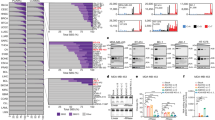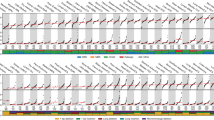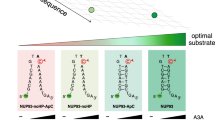Abstract
Elucidation of mutagenic processes shaping cancer genomes is a fundamental problem whose solution promises insights into new treatment, diagnostic and prevention strategies1. Single-strand DNA–specific APOBEC cytidine deaminase(s) are major source(s) of mutation in several cancer types2,3,4. Previous indirect evidence implicated APOBEC3B as the more likely major mutator deaminase, whereas the role of APOBEC3A is not established5,6. Using yeast models enabling the controlled generation of long single-strand genomic DNA substrates7, we show that the mutation signatures of APOBEC3A and APOBEC3B are statistically distinguishable. We then apply three complementary approaches to identify cancer samples with mutation signatures resembling either APOBEC. Strikingly, APOBEC3A-like samples have over tenfold more APOBEC-signature mutations than APOBEC3B-like samples. We propose that APOBEC3A-mediated mutagenesis is much more frequent because APOBEC3A itself is highly proficient at generating DNA breaks8,9,10, whose repair can trigger the formation of single-strand hypermutation substrates.
This is a preview of subscription content, access via your institution
Access options
Subscribe to this journal
Receive 12 print issues and online access
$209.00 per year
only $17.42 per issue
Buy this article
- Purchase on Springer Link
- Instant access to full article PDF
Prices may be subject to local taxes which are calculated during checkout






Similar content being viewed by others
References
Stratton, M.R. Exploring the genomes of cancer cells: progress and promise. Science 331, 1553–1558 (2011).
Alexandrov, L.B. et al. Signatures of mutational processes in human cancer. Nature 500, 415–421 (2013).
Burns, M.B., Temiz, N.A. & Harris, R.S. Evidence for APOBEC3B mutagenesis in multiple human cancers. Nat. Genet. 45, 977–983 (2013).
Roberts, S.A. et al. An APOBEC cytidine deaminase mutagenesis pattern is widespread in human cancers. Nat. Genet. 45, 970–976 (2013).
Burns, M.B., Leonard, B. & Harris, R.S. APOBEC3B: pathological consequences of an innate immune DNA mutator. Biomed. J. 38, 102–110 (2015).
Harris, R.S. Molecular mechanism and clinical impact of APOBEC3B-catalyzed mutagenesis in breast cancer. Breast Cancer Res. 17, 8 (2015).
Chan, K. et al. Base damage within single-strand DNA underlies in vivo hypermutability induced by a ubiquitous environmental agent. PLoS Genet. 8, e1003149 (2012).
Landry, S., Narvaiza, I., Linfesty, D.C. & Weitzman, M.D. APOBEC3A can activate the DNA damage response and cause cellcycle arrest. EMBO Rep. 12, 444–450 (2011).
Burns, M.B. et al. APOBEC3B is an enzymatic source of mutation in breast cancer. Nature 494, 366–370 (2013).
Mussil, B. et al. Human APOBEC3A isoforms translocate to the nucleus and induce DNA double strand breaks leading to cell stress and death. PLoS ONE 8, e73641 (2013).
Nik-Zainal, S. et al. Mutational processes molding the genomes of 21 breast cancers. Cell 149, 979–993 (2012).
Roberts, S.A. et al. Clustered mutations in yeast and in human cancers can arise from damaged long single-strand DNA regions. Mol. Cell 46, 424–435 (2012).
Bishop, K.N. et al. Cytidine deamination of retroviral DNA by diverse APOBEC proteins. Curr. Biol. 14, 1392–1396 (2004).
Dang, Y., Wang, X., Esselman, W.J. & Zheng, Y.-H. Identification of APOBEC3DE as another antiretroviral factor from the human APOBEC family. J. Virol. 80, 10522–10533 (2006).
Harris, R.S., Petersen-Mahrt, S.K. & Neuberger, M.S. RNA editing enzyme APOBEC1 and some of its homologs can act as DNA mutators. Mol. Cell 10, 1247–1253 (2002).
Henry, M. et al. Genetic editing of HBV DNA by monodomain human APOBEC3 cytidine deaminases and the recombinant nature of APOBEC3G. PLoS ONE 4, e4277 (2009).
Yu, Q. et al. APOBEC3B and APOBEC3C are potent inhibitors of simian immunodeficiency virus replication. J. Biol. Chem. 279, 53379–53386 (2004).
Cescon, D.W., Haibe-Kains, B. & Mak, T.W. APOBEC3B expression in breast cancer reflects cellular proliferation, while a deletion polymorphism is associated with immune activation. Proc. Natl. Acad. Sci. USA 112, 2841–2846 (2015).
Waters, C.E., Saldivar, J.C., Amin, Z.A., Schrock, M.S. & Huebner, K. FHIT loss–induced DNA damage creates optimal APOBEC substrates: insights into APOBEC-mediated mutagenesis. Oncotarget 6, 3409–3419 (2015)
Sasaki, H. et al. APOBEC3B gene overexpression in non-small-cell lung cancer. Biomed. Rep. 2, 392–395 (2014).
Leonard, B. et al. APOBEC3B upregulation and genomic mutation patterns in Serous ovarian carcinoma. Cancer Res. 73, 7222–7231 (2013).
de Bruin, E.C. et al. Spatial and temporal diversity in genomic instability processes defines lung cancer evolution. Science 346, 251–256 (2014).
Caval, V., Suspène, R., Vartanian, J.-P. & Wain-Hobson, S. Orthologous mammalian APOBEC3A cytidine deaminases hypermutate nuclear DNA. Mol. Biol. Evol. 31, 330–340 (2014).
Shee, C. et al. Engineered proteins detect spontaneous DNA breakage in human and bacterial cells. eLife 2, e01222 (2013).
Nik-Zainal, S. et al. Association of a germline copy number polymorphism of APOBEC3A and APOBEC3B with burden of putative APOBEC-dependent mutations in breast cancer. Nat. Genet. 46, 487–491 (2014).
Caval, V., Suspène, R., Shapira, M., Vartanian, J.-P. & Wain-Hobson, S. A prevalent cancer susceptibility APOBEC3A hybrid allele bearing APOBEC3B 3′ UTR enhances chromosomal DNA damage. Nat. Commun. 5, 5129 (2014).
Roberts, S.A. & Gordenin, D.A. Hypermutation in human cancer genomes: footprints and mechanisms. Nat. Rev. Cancer 14, 786–800 (2014).
Poon, S.L., McPherson, J.R., Tan, P., Teh, B.T. & Rozen, S.G. Mutation signatures of carcinogen exposure: genome-wide detection and new opportunities for cancer prevention. Genome Med. 6, 24 (2014).
Degtyareva, N.P. et al. Oxidative stress–induced mutagenesis in single-strand DNA occurs primarily at cytosines and is DNA polymerase ζ–dependent only for adenines and guanines. Nucleic Acids Res. 41, 8995–9005 (2013).
O'Shea, J.P. et al. pLogo: a probabilistic approach to visualizing sequence motifs. Nat. Methods 10, 1211–1212 (2013).
Taylor, B.J. et al. DNA deaminases induce break-associated mutation showers with implication of APOBEC3B and 3A in breast cancer kataegis. eLife 2, e00534 (2013).
Fredriksson, N.J., Ny, L., Nilsson, J.A. & Larsson, E. Systematic analysis of noncoding somatic mutations and gene expression alterations across 14 tumor types. Nat. Genet. 46, 1258–1263 (2014).
Walker, B.A. et al. APOBEC family mutational signatures are associated with poor prognosis translocations in multiple myeloma. Nat. Commun. 6, 6997 (2015).
Long, J. et al. A common deletion in the APOBEC3 genes and breast cancer risk. J. Natl. Cancer Inst. 105, 573–579 (2013).
Xuan, D. et al. APOBEC3 deletion polymorphism is associated with breast cancer risk among women of European ancestry. Carcinogenesis 34, 2240–2243 (2013).
Chan, K., Resnick, M.A. & Gordenin, D.A. The choice of nucleotide inserted opposite abasic sites formed within chromosomal DNA reveals the polymerase activities participating in translesion DNA synthesis. DNA Repair (Amst.) 12, 878–889 (2013).
Drier, Y. et al. Somatic rearrangements across cancer reveal classes of samples with distinct patterns of DNA breakage and rearrangement-induced hypermutability. Genome Res. 23, 228–235 (2013).
Mimitou, E.P. & Symington, L.S. DNA end resection—unraveling the tail. DNA Repair (Amst.) 10, 344–348 (2011).
Sakofsky, C.J. et al. Break-induced replication is a source of mutation clusters underlying kataegis. Cell Rep. 7, 1640–1648 (2014).
The Cancer Genome Atlas Research Network. Comprehensive molecular characterization of urothelial bladder carcinoma. Nature 507, 315–322 (2014).
Davis, C.F. et al. The somatic genomic landscape of chromophobe renal cell carcinoma. Cancer Cell 26, 319–330 (2014).
Broad Institute TCGA Genome Data Analysis Center. Analysis of Mutagenesis by APOBEC Cytidine Deaminases (P-MACD) (Broad Institute of MIT and Harvard, 2014).
Rooney, M.S., Shukla, S.A., Wu, C.J., Getz, G. & Hacohen, N. Molecular and genetic properties of tumors associated with local immune cytolytic activity. Cell 160, 48–61 (2015).
Snyder, A. et al. Genetic basis for clinical response to CTLA-4 blockade in melanoma. N. Engl. J. Med. 371, 2189–2199 (2014).
Casey, R.G. et al. Diagnosis and management of urothelial carcinoma in situ of the lower urinary tract: a systematic review. Eur. Urol. 67, 876–888 (2015).
Powles, T. et al. MPDL3280A (anti–PD-L1) treatment leads to clinical activity in metastatic bladder cancer. Nature 515, 558–562 (2014).
Bellí, G., Garí, E., Piedrafita, L., Aldea, M. & Herrero, E. An activator/repressor dual system allows tight tetracycline-regulated gene expression in budding yeast. Nucleic Acids Res. 26, 942–947 (1998).
Storici, F. & Resnick, M.A. in Methods Enzymology Vol. 409 (eds. Judith, L.C. & Paul, M.) 329–345 (Academic Press, 2006).
Morrison, A., Bell, J.B., Kunkel, T.A. & Sugino, A. Eukaryotic DNA polymerase amino acid sequence required for 3′→5′ exonuclease activity. Proc. Natl. Acad. Sci. USA 88, 9473–9477 (1991).
Sakamoto, A.N. et al. Mutator alleles of yeast DNA polymerase ζ. DNA Repair (Amst.) 6, 1829–1838 (2007).
Matsuda, T., Bebenek, K., Masutani, C., Hanaoka, F. & Kunkel, T.A. Low fidelity DNA synthesis by human DNA polymerase-ɛ. Nature 404, 1011–1013 (2000).
Haldane, J.B.S. On a method of estimating frequencies. Biometrika 33, 222–225 (1945).
Lawrence, M.S. et al. Mutational heterogeneity in cancer and the search for new cancer-associated genes. Nature 499, 214–218 (2013).
Benjamini, Y. & Hochberg, Y. Controlling the false discovery rate: a practical and powerful approach to multiple testing. J. R. Stat. Soc. B 57, 289–300 (1995).
Maiorov, V.N. & Crippen, G.M. Significance of root-mean-square deviation in comparing three-dimensional structures of globular proteins. J. Mol. Biol. 235, 625–634 (1994).
Acknowledgements
We thank T.A. Kunkel, S.A. Lujan and D.V. Zaykin for critical reading of the manuscript. This work was supported by US National Institutes of Health Intramural Research Program Project Z1AES103266 to D.A.G. and US National Institutes of Health grants U24CA143845 to G.G., R01GM052319 to P.A.M., 1P01CA120964 to D.J.K., R00ES022633 to S.A.R. and K99ES024424 to K.C.
Author information
Authors and Affiliations
Contributions
K.C. and D.A.G. designed the study. K.C., S.A.R., J.F.S., N.S., E.P.M. and P.A.M. performed the experiments. K.C., L.J.K., J.K., D.C.F. and G.G. performed statistical analyses. K.C., L.J.K., N.S., J.K., D.J.K., D.C.F., G.G. and D.A.G. analyzed the data. S.A.R., L.J.K. and P.A.M. contributed reagents, materials or analysis tools. K.C. and D.A.G. wrote the manuscript, with contributions from S.A.R., N.S., D.J.K. and G.G.
Corresponding author
Ethics declarations
Competing interests
The authors declare no competing financial interests.
Integrated supplementary information
Supplementary Figure 1 Comparison with the published yeast data.
(a,b) The frequencies of nucleotides near deamination sites are graphed for (a) A3A or (b) A3B expressed in yeast by Taylor et al. in ref.31 (upper panels) and by our group (lower panels). Deaminated cytosines are aligned at 0 on the horizontal axis, flanked by five bases 5′ (–5 to −1) and 3′ (+1 to +5). (c–h) pLogos were generated for C-to-T substitutions from Taylor et al., fixed for C at position 0 (c,d), for TC (e,f) and for TCA (g,h). Note the similarities to the pLogos in Figure 1a–f. (i) Clusters from this study’s yeast data have significantly more mutations per cluster than those from Taylor et al. (j) The A3A clusters from this study span a greater number of bases than the clusters from Taylor et al. Means with 95% confidence intervals and Kolmogorov-Smirnov P values are included in i and j.
Supplementary Figure 2 TCA enrichment versus TCW enrichment in other cohorts.
Samples are binned by quartile of TCW enrichment. Note the varying scale of the axes. (a–j) Per-sample TCA enrichment versus TCW enrichment is plotted for ten WGS cohorts with low levels of or no APOBEC signature mutagenesis, namely (a) colorectal, (b) glioblastoma multiforme, (c) kidney chromophobe, (d) kidney clear cell, (e) lower-grade glioma, (f) multiple myeloma, (g) prostate, (h) melanoma, (i) thyroid and (j) uterine endometrial. The apparently high enrichment in h is likely due to overlap with the signature of ultraviolet light mutagenesis. (k–p) Per-sample TCA enrichment versus TCW enrichment is plotted for six exome cohorts with high levels of APOBEC signature mutagenesis, from (k) bladder, (l) breast, (m) cervical, (n) head and neck, (o) lung adenocarcinoma and (p) lung squamous cell. Similar to genome samples of these cancer types, exome samples with TCW enrichment >2 tend to have even higher TCA enrichment.
Supplementary Figure 3 Correlation between log of mRNA abundance for A3A or A3B and log of minimal estimate + 1 of TCA mutations induced by APOBEC.
Spearman correlation (ρ) and corresponding P values are computed and shown on log-log plots for (a) all five high-TCA cancer cohorts combined and (b) bladder, (c) breast, (d) head and neck, (e) lung adenocarcinoma and (f) lung squamous cell. Unfilled symbols denote samples not significantly enriched for TCA. Samples with significant TCA enrichment are binned by quartiles. Adding 1 (an arbitrary constant) is necessary to visualize samples with a TCA mutation minimal estimate of 0 on a log scale. In a, c and e, A3A and A3B mRNA abundances both are correlated with mutation load. In b and f, neither is correlated. Only in d is there a distinction, where A3A abundance is correlated, while A3B abundance is not.
Supplementary Figure 4 YTCA enrichment versus RTCA enrichment for samples that were significantly enriched for TCA.
All samples are binned by quartile of TCA enrichment. Unfilled, gray-bordered symbols denote samples where the ratio of YTCA to RTCA mutation is not statistically different from random, regardless of TCA enrichment. (a–e) Whole-genome analysis results for (a) colorectal, (b) multiple myeloma, (c) melanoma, (d) thyroid and (e) uterine endometrial cancer cohorts are shown. Note that the apparently high presence of TCA APOBEC signature–enriched samples in melanoma is likely artifactual, due to considerable overlap with the mutation signature for ultraviolet light (C→T mutations at dipyrimidines) (discussed in ref. 27). No samples are significantly enriched for TCA among the other five cohorts (glioblastoma multiforme, kidney chromophobe, kidney renal clear cell, lower-grade glioma and prostate) with whole-genome mutation data. (f–k) Results for whole-exome mutation data from (f) bladder, (g) breast, (h) cervical, (i) head and neck, (j) lung adenocarcinoma and (k) lung squamous cell cohorts are shown. Most samples fail to pass statistical filtering for a non-random ratio of YTCA mutations to RTCA mutations, because of the low mutation counts per sample and the large numbers of samples within each cohort. The few samples that do pass statistical filtering all had high mutation counts and A3A-like signatures. These results show that, in low–APOBEC mutagenesis genomes or high–APOBEC mutagenesis exomes, samples that do pass both levels of statistical filtering tend to have high TCA enrichments and A3A-like signatures (YTCA > RTCA enrichment).
Supplementary Figure 5 Summary of analyses for five high–APOBEC mutagenesis genome cohorts.
NTCA and pLogo analysis results are shown for (a) bladder, (b) breast, (c) head and neck, (d) lung adenocarcinoma and (e) lung squamous cell cohorts. Samples are filtered for significant TCA enrichment and for a non-random proportion of NTCA mutations. Then, these samples are binned by quartile of TCA enrichment (values shown below the horizontal axis of each RMSD graph). The pLogo for each quartile of samples is shown below the respective RMSD graph. P values from χ2 tests for trend (reported on the left of each section of the figure) are significant for each cohort, confirming increasing A3A-like character as TCA enrichment increases.
Supplementary Figure 6 Data on TCGA A3B germline deletion samples.
(a) Y/RTCA analysis for A3B germline deletion samples from five TCGA high-APOBEC cohorts (all heterozygous). (b) Y/RTCA analysis for A3B wild-type samples from the same cohorts. Fisher’s exact test P value = 0.0752, comparing A3B genotypes to mutation signature types. (c) RMSDs versus A3A or A3B for A3B germline deletion samples from the same cohorts (all heterozygous). (d,e) Shown are analogous data for A3B WT samples, split between (d) A3A-like and (e) A3B-like subsets. Fisher’s exact test P value = 0.0297 (comparing A3B genotypes to mutation signature types), confirming significant skewing toward A3A-like signatures among A3B deletion samples. (f) Histograms of A3B copy number data, showing subsets of samples that have values significantly lower (upper panel) or higher (lower panel) than the wild-type standard of 2. Samples left of the blue dotted line are called as homozygous deletions. Those between the blue and green dotted lines are called heterozygous deletions. Samples to the right of the dotted red line are called amplifications. The majority of samples (>5,600) are wild type (near copy number 2) and are omitted from these plots to show the less numerous copy number variation–bearing samples more clearly.
Supplementary information
Supplementary Text and Figures
Supplementary Figures 1–6. (PDF 1810 kb)
Supplementary Table 1
This file summarizes the yeast data obtained in this study, as well as reanalysis of data previously published in Taylor et al., 2013 (ref.31). (XLSX 2498 kb)
Supplementary Table 2
This file contains data used for computing enrichment values from each cancer data set. (XLSX 33 kb)
Supplementary Table 3
This file summarizes data pertaining to minimal estimates of TCA→TGA/TTA mutations added by APOBEC(s) in six whole-genome cohorts. (XLSX 42 kb)
Supplementary Table 4
This file contains the sequences of the primers used to amplify each A3A/A3B-hph cassette by PCR for targeted gene replacement of LEU2 in yeast. (XLSX 10 kb)
Source data
Rights and permissions
About this article
Cite this article
Chan, K., Roberts, S., Klimczak, L. et al. An APOBEC3A hypermutation signature is distinguishable from the signature of background mutagenesis by APOBEC3B in human cancers. Nat Genet 47, 1067–1072 (2015). https://doi.org/10.1038/ng.3378
Received:
Accepted:
Published:
Issue Date:
DOI: https://doi.org/10.1038/ng.3378
This article is cited by
-
Mesoscale DNA features impact APOBEC3A and APOBEC3B deaminase activity and shape tumor mutational landscapes
Nature Communications (2024)
-
Distinguishing preferences of human APOBEC3A and APOBEC3B for cytosines in hairpin loops, and reflection of these preferences in APOBEC-signature cancer genome mutations
Nature Communications (2024)
-
DEEPOMICS FFPE, a deep neural network model, identifies DNA sequencing artifacts from formalin fixed paraffin embedded tissue with high accuracy
Scientific Reports (2024)
-
The role of APOBEC3B in lung tumor evolution and targeted cancer therapy resistance
Nature Genetics (2024)
-
APOBEC3-mediated mutagenesis in cancer: causes, clinical significance and therapeutic potential
Journal of Hematology & Oncology (2023)



